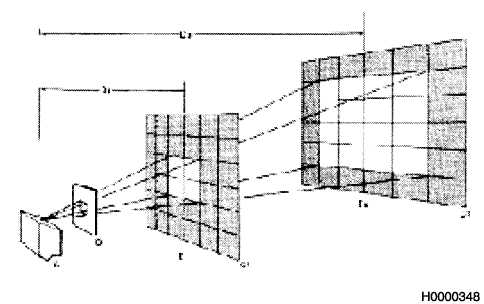T.O. 33B-1-1
Where:
T1 = Original Exposure (MAS).
T2 = New Exposure (MAS).
D1 = Original Distance (SFD).
D2 = New Distance (SFD).
For example, a technique calls for exposing a part at 36 inches using 300 mas. However, the tube head needs
to be moved to make a 48 inch SFD, what would the new exposure be?
Substituting:
Cross multiplying gives (T2) * (1296) = (300) * (2304) or T2 = (300 * 2304)/1296.
Solving, T2 = 533 MAS, which would be our new exposure.
6.7.2.9
Inverse Square Law.
When the X-ray tube output is held constant or when a particular radioactive source is used, the radiation
intensity reaching the specimen is governed by the distance between the tube (or source) and the specimen,
varying inversely with the square of this distance. The explanation below is in terms of X-rays and visible
light but applies with equal force to gamma rays as well. Since X-rays conform to the laws of light, they
diverge when they are emitted from the anode and cover an increasing larger area with lessened intensity as
they travel from their source. This principle is illustrated by Figure 6-26.
Figure 6-26.
Inverse Square Law Diagram
6.7.2.9.1
In this example it is assumed that the intensity of the X-rays emitted at the anode (A) remains constant, and
that the X-rays passing through the aperture (B) cover an area 4 square inches on reaching and recording
surface (C1), which is 12 inches (D) from (A). Then when the recording surface (C1) is moved 12 inches farther
from the anode to (C2), so that the distance between (A) and (C2) is 24 inches (2D) or twice the distance
between (A) and (C1); the X-rays will cover l6 square inches, an area of 4 times as great as that at (C1). It
Change 3
6-57




